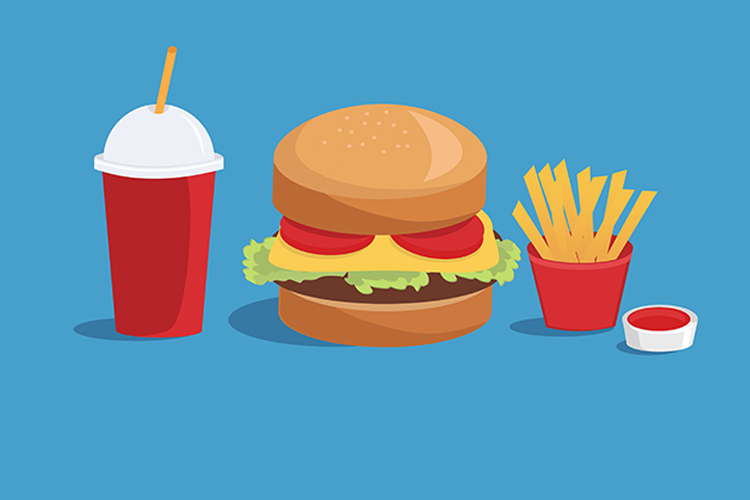Blog
Say goodbye to combo deals for our kids health
McDonald’s, Burger King, Subway and the rest, listen up! It may be time to say goodbye to the combo meal deal for the sake of our children’s health.
A recent study out of the NYU Langone Medical Center, and published in the American Journal of Public Health, analysed the meals of 483 1-18-year-olds and their parents over a year and a half.1
It found kids consume more energy when sold a meal that includes a bonus sweetened beverage. Specifically, that’s 179 more empty calories on average, delivered to kids by soft drinks, juice, sweetened tea or flavoured milk.
And the parents were 24% more likely to sip on a soft drink if a combo meal was bought, compared to those who didn’t partake in the deals.
“Our study strongly suggests that uncoupling sugary drinks from combo meal deals might reduce high-calorie beverage consumption and help to curb childhood obesity rates fueled by these kinds of liquid calories,” says senior study investigator, Brian Elbel, PhD.
74% of the combo meals purchased were kids meals. A worry considering one small pre-mix cola from Macca’s exceeds the recommended 25g limit of added sugar intake for kids over the age of 2 (and no added sugar whatsoever is recommended for those younger!).
It’s a steal!
Choosing a combo deal over ordering items separately isn’t surprising – we love a good value! But what seems like a steal at the time we may pay for in the future.
Currently, 1 in 2 children has tooth decay, every 6 seconds 1 person dies from diabetes – a majority of these type 2, 1 in 4 Australian children are overweight or obese, and up to 30% of adults and 10% of children have non-alcoholic fatty liver disease. All these can be associated with the overconsumption of added sugar and sugary drinks.2-6
The number of kids enduring an obesity-related disease is predicted to rise dramatically within the next 10 years (up to 12 million children will have insulin resistance, 4 million will have type 2 diabetes, 27 million will have high blood pressure, and 38 million will have fatty liver by 2025). It is time to take action.7
It’s about health
Let’s just clarify we do not want to vilify those who are overweight or obese when discussing such topics. We share this kind of information and research only out of concern for health and quality of life.
We are in full support of all people – children and adults alike – to maintain a healthy body weight. And what the ideal weight is will vary from person to person.
However, when one is obese, quality of life can be impacted, and serious disease burden may ensue – including cardiovascular disease, type 2 diabetes, depression, cancer, joint and mobility issues, to name a few.
Whilst the super-sized combo-deal pre-mix Coke may not be the only cause of the increase in our children’s weight, sugary drinks are nutritionally devoid, offering empty kilojoules and health damaging qualities.
Regardless if we are asking big fast-food chains to take action to help curb the rise of obesity in children, we must also make sure we act at home to avoid our kids, and ourselves, becoming too unwell.
The family environment can be the strongest influencer of what we eat. So lead by example, and have good nourishing foods at home, and leave the sugary drinks alone.
By Angela Johnson (BHSc Nut. Med.)
References:
- Cantor, J, Breck, A, & Elbel, B 2016, ‘Correlates of Sugar-Sweetened Beverages Purchased for Children at Fast-Food Restaurants’,American Journal of Public Health, vol. 106, no. 11, pp. 2038-2041
- AIHW n.d., Overweight and Obesity, viewed 17 October 2016, <http://www.aihw.gov.au/overweight-and-obesity/>
- Diabetes Australia 2015, Diabetes Globally, viewed 17 October 2016, <https://www.diabetesaustralia.com.au/diabetes-globally>
- Feldstein, AE, Charatcharoenwitthaya, P, Treeprasertsuk, S, Benson, JT, Enders, FB, & Angulo, P 2009, ‘The natural history of non-alcoholic fatty liver disease in children: a follow-up study for up to 20 years’, Gut, vol. 58, no. 11, pp. 1538-1544.
- Ha DH, Amarasena N & Crocombe L 2013, ‘The dental health of Australia’s children by remoteness: Child Dental Health Survey Australia 2009’, AIHW, Dental statistics and research series 63. Cat. no. DEN 225. Canberra.
- Harvard School of Public Health 2016, Child Obesity, viewed 17 October 2016, <https://www.hsph.harvard.edu/obesity-prevention-source/obesity-trends/global-obesity-trends-in-children/>
- Lobstein, T, & Jackson-Leach, R 2016, ‘Planning for the worst: estimates of obesity and comorbidities in school-age children in 2025’,Pediatric Obesity, vol. 11, no. 5, pp. 321-325.












